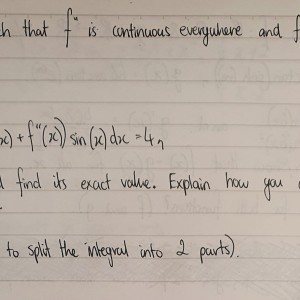Early uni/college Calculus (one question)
Attatched question pic below. Answer doesn't have to be long, can be somewhat middle of short n long, but precise or straight to the point with the working. Thank you.
 Limahun
Limahun
18
Answer
Answers can only be viewed under the following conditions:
- The questioner was satisfied with and accepted the answer, or
- The answer was evaluated as being 100% correct by the judge.
 Dynkin
Dynkin
779
-
comment: upon reading the answer again I note that I made a miscalculation. In the third equation one should get f(\pi) * (1) - f(0) * (-1) instead of f(\pi) *(-1) - f(0)*(-1) - as cos(\pi)=-1 not 1. This should then enter into the second to last equation where you get 4 = f(0) + 9, the solution then becomes f(0)= 4-9 = -5.
-
Unfortunately it is not possible to edit answers once they are submitted, which is why I must put the correction in a comment instead.
-
Yes that is all good, thanks so much for your help!
The answer is accepted.
Join Matchmaticians Affiliate Marketing
Program to earn up to a 50% commission on every question that your affiliated users ask or answer.
- answered
- 1328 views
- $3.00
Related Questions
- Find and simplify quotient
- Compound Interest question
- Find the absolute extrema of $f(x,y) = x^2 - xy + y^2$ on $|x| + |y| \leq 1$.
- Convergence of $\int_{1}^{\infty} e^{\sin(x)}\cdot\frac{\sin(x)}{x^2} $
- Inverse function evaluation
- Rouche’s Theorem applied to the complex valued function $f(z) = z^6 + \cos z$
- Is $\int_0^{\infty}\frac{x+3}{x^2+\cos x}$ convergent?
- Application of Integrals

